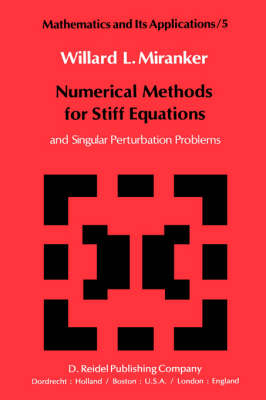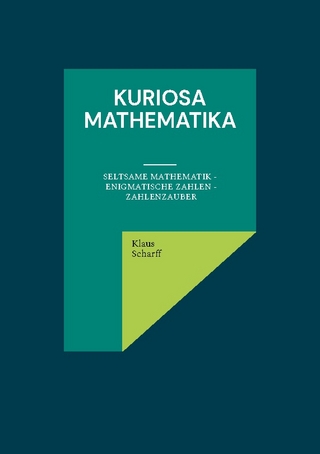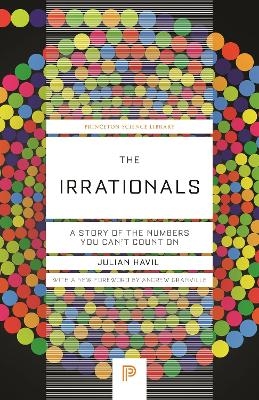
Numerical Methods for Stiff Equations
Kluwer Academic Publishers (Verlag)
978-90-277-1107-6 (ISBN)
- Titel ist leider vergriffen;
keine Neuauflage - Artikel merken
Further, the kind and level of sophistication of mathematics applied in various sciences has changed drastically in recent years: measure theory is used (non-trivially) in regional and theoretical economics; algebraic geometry interacts with physics; the Minkowsky lemma, coding theory and the structure of water meet one another in packing and covering theory; quantum fields, crystal defects and mathematical programming profit from homotopy theory; Lie algebras are relevant to filtering; and prediction and electrical engineering can use Stein spaces.
1. Introduction.- Summary.- 1.1. Stiffness and Singular Perturbations.- 1.1.1. Motivation.- 1.1.2. Stiffness.- 1.1.3. Singular Perturbations.- 1.1.4. Applications.- 1.2. Review of the Classical Linear Multistep Theory.- 1.2.1. Motivation.- 1.2.2. The Initial Value Problem.- 1.2.3. Linear Multistep Operators.- 1.2.4. Approximate Solutions.- 1.2.5. Examples of Linear Multistep Methods.- 1.2.6. Stability, Consistency and Convergence.- 2. Methods of Absolute Stability.- Summary.- 2.1. Stiff Systems and A-stability.- 2.1.1. Motivation.- 2.1.2. A-stability.- 2.1.3. Examples of A-stable Methods.- 2.1.4. Properties of A-stable Methods.- 2.1.5. A Sufficient Condition for A-stability.- 2.1.6. Applications.- 2.2. Notions of Diminished Absolute Stability.- 2.2.1. A (?)-stability.- 2.2.2. Properties of A(?)-stable Methods.- 2.2.3. Stiff Stability.- 2.3. Solution of the Associated Equations.- 2.3.1. The Problem.- 2.3.2. Conjugate Gradients and Dichotomy.- 2.3.3. Computational Experiments.- 3. Nonlinear Methods.- Summary.- 3.1. Interpolatory Methods.- 3.1.1. Certaine's Method.- 3.1.2. Jain's Method.- 3.2. Runge-Kutta Methods and Rosenbrock Methods.- 3.2.1. Runge-Kutta Methods with v-levels.- 3.2.2. Determination of the Coefficients.- 3.2.3. An Example.- 3.2.4. Semi-explicit Processes and the Method of Rosenbrock.- 3.2.5. A-stability.- 4 Exponential Fitting.- Summary.- 4.1. Exponential Fitting for Linear Multistep Methods.- 4.1.1. Motivation and Examples.- 4.1.2. Minimax fitting.- 4.1.3. An Error Analysis for an Exponentially Fitted F1.- 4.2. Fitting in the Matricial Case.- 4.2.1. The Matricial Multistep Method.- 4.2.2. The Error Equation.- 4.2.3. Solution of the Error Equation.- 4.2.4. Estimate of the Global Error.- 4.2.5. Specification of P.- 4.2.6. Specification of L and R.- 4.2.7. An Example.- 4.3. Exponential Fitting in the Oscillatory Case.- 4.3.1. Failure of the Previous Methods.- 4.3.2. Aliasing.- 4.3.3. An Example of Aliasing.- 4.3.4. Application to Highly Oscillatory Systems.- 4.4. Fitting in the Case of Partial Differential Equations.- 4.4.1. The Problem Treated.- 4.4.2. The Minimization Problem.- 4.4.3. Highly Oscillatory Data.- 4.4.4. Systems.- 4.4.5. Discontinuous Data.- 4.4.6. Computational Experiments.- 5. Methods of Boundary Layer Type.- Summary.- 5.1. The Boundary Layer Numerical Method.- 5.1.1. The Boundary Layer Formalism.- 5.1.2. The Numerical Method.- 5.1.3. An Example.- 5.2. The ?-independent Method.- 5.2.1. Derivation of the Method.- 5.2.2. Computational Experiments.- 5.3. The Extrapolation Method.- 5.3.1. Derivation of the Relaxed Equations.- 5.3.2. Computational Experiments.- 6. The Highly Oscillatory Problem.- Summary.- 6.1. A Two-time Method for the Oscillatory Problem.- 6.1.1. The Model Problem.- 6.1.2. Numerical Solution Concept.- 6.1.3. The Two-time Expansion.- 6.1.4. Formal Expansion Procedure.- 6.1.5. Existence of the Averages and Estimates of the Remainder.- 6.1.6. The Numerical Algorithm.- 6.1.7. Computational Experiments.- 6.2. Algebraic Methods for the Averaging Process.- 6.2.1. Algebraic Characterization of Averaging.- 6.2.2. An Example.- 6.2.3. Preconditioning.- 6.3. Accelerated Computation of Averages and an Extrapolation Method.- 6.3.1. The Multi-time Expansion in the Nonlinear Case.- 6.3.2. Accelerated Computation of $$/bar f$$.- 6.3.3. The Extrapolation Method.- 6.3.4. Computational Experiments: A Linear System.- 6.3.5. Discussion.- 6.4. A Method of Averaging.- 6.4.1. Motivation: Stable Functionals.- 6.4.2. The Problem Treated.- 6.4.3. Choice of Functionals.- 6.4.4. Representers.- 6.4.5. Local Error and Generalized Moment Conditions.- 6.4.6. Stability and Global Error Analysis.- 6.4.7. Examples.- 6.4.8. Computational Experiments.- 4.6.9. The Nonlinear Case and the Case of Systems.- 7. Other Singularly Perturbed Problems.- Summary.- 7.1. Singularly Perturbed Recurrences.- 7.1.1. Introduction and Motivation.- 7.1.2. The Two-time Formalism for Recurrences.- 7.1.3. The Averaging Procedure.- 7.1.4. The Linear Case.- 7.1.5. Additional Applications.- 7.2. Singularly Perturbed Boundary Value Problems.- 7.2.1. Introduction.- 7.2.2. Numerically Exploitable Form of the Connection Theory.- 7.2.3. Description of the Algorithm.- 7.2.4. Computational Experiments.- References.
| Reihe/Serie | Mathematics and Its Applications ; 5 |
|---|---|
| Zusatzinfo | biography |
| Verlagsort | Dordrecht |
| Sprache | englisch |
| Maße | 152 x 229 mm |
| Gewicht | 1110 g |
| Einbandart | gebunden |
| Themenwelt | Mathematik / Informatik ► Informatik |
| Mathematik / Informatik ► Mathematik ► Arithmetik / Zahlentheorie | |
| ISBN-10 | 90-277-1107-0 / 9027711070 |
| ISBN-13 | 978-90-277-1107-6 / 9789027711076 |
| Zustand | Neuware |
| Informationen gemäß Produktsicherheitsverordnung (GPSR) | |
| Haben Sie eine Frage zum Produkt? |
aus dem Bereich


